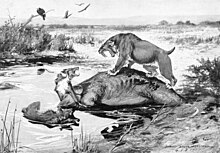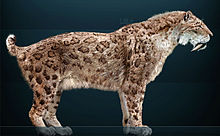From Wikipedia, the free encyclopedia
| Smilodon Temporal range: Pleistocene 2.5–0.009Ma |
|
|---|---|
 |
|
| Smilodon fatalis skeleton at the National Museum of Nature and Science, Tokyo, Japan | |
| Scientific classification | |
| Kingdom: | Animalia |
| Phylum: | Chordata |
| Class: | Mammalia |
| Order: | Carnivora |
| Family: | Felidae |
| Subfamily: | †Machairodontinae |
| Tribe: | †Smilodontini |
| Genus: | †Smilodon Lund, 1841 |
| Species | |
Overall, Smilodon was more robustly built than any modern cat, with particularly well-developed forelimbs and exceptionally long upper canines. Its jaw had a bigger gape than modern cats and its upper canines were slender and fragile, being adapted for precision killing. These attributes made Smilodon a specialized hunter of large herbivores like bison and camels.
Smilodon likely lived in closed habitats like forests and bush which would have provided cover for ambushing prey. Its reliance on large animals may have been the cause of its extinction. Scientists debate over whether Smilodon was a social animal. Comparison of predator responses to distress calls and the prevalence of healed injuries suggest it was social, while its small brain size and vegetated habitat suggest it was more solitary. Some fossils show signs of ankylosing spondylitis, trauma and arthritis. Smilodon went extinct 10,000 years ago.
Contents
Etymology
The nickname "saber-tooth" refers to the extreme length of their maxillary canines. Despite the colloquial name "saber-toothed tiger", Smilodon is not closely related to the tiger (or any other living felid); the latter belongs to subfamily Pantherinae, whereas Smilodon belongs to subfamily Machairodontinae. The name Smilodon comes from Greek: σμίλη, (smilē), "carving knife"[1] + ὀδoύς (odoús), "tooth" (whose stem is odont-, as seen in the genitive case form ὀδόντος, odóntos).[2]Classification
The genus Smilodon was named and described by the Danish naturalist and palaeontologist Peter Wilhelm Lund in 1842. He found the fossils of Smilodon populator in caves near the small town of Lagoa Santa, in the state of Minas Gerais, Brazil.[3] It is grouped with several species of saber-toothed cats in the subfamily Machairodontinae within the family Felidae. An early ancient DNA analysis suggested that Smilodon be grouped with modern cats (subfamily Felinae)[4] However, a 2005 study found that Smilodon belonged to a separate lineage.[5] Another study published a year later confirmed this, showing that the Machairodontinae diverged early from the ancestors of modern cats and were not closely related to any living feline species.[6] The skull and mandible morphology of the earliest saber-toothed cats were similar to that of clouded leopards. The lineage further adapted to precision killing of large animals with elongated canine teeth and wider gapes, in the process sacrificing high bite force.[7] Smilodon belongs to the tribe Smilodontini, which are known as "dirk-toothed cats". These cats were defined by their long slender canines with fine serrations.[8]Species
A number of Smilodon species have been described, but today usually only three are recognized.[9]- Smilodon gracilis, 2.5 million–500,000 years ago; the smallest and earliest species, estimated at 55 to 100 kg (120 to 220 lb) in weight[10] was the successor of Megantereon in North America, from which it probably evolved. This species reached the north of South America in the early Pleistocene, along with Homotherium.[11] The other Smilodon species probably derived from this species. As its specific name suggests, this species is the most lightly built of the genus.[3] In terms of size, it was intermediate between S. fatalis and S. populator.[9]
- Smilodon fatalis, 1.6 million–10,000 years ago, replaced S. gracilis in North America and invaded western South America as part of the Great American Interchange.[12] It ranged from 160 to 280 kg (350 to 620 lb).[10] and reached a shoulder height of 100 cm (39 in) and body length of 175 cm (69 in).[13] Sometimes two additional species are recognized, S. californicus and S. floridanus, but usually they are considered to be junior synonyms of S. fatalis.[14]
- Smilodon populator, 1 million–10,000 years ago; occurred in the eastern parts of South America and was larger than the North American species.[15] It is perhaps the largest known felid with a body mass range of 220 to 400 kg (490 to 880 lb).[10][16] It stand at a shoulder height of 120 cm (47 in).[9] Compared to S. fatalis, S. populator had a more elongated and narrow skull, higher positioned nasals, more massive metapodials and slightly longer forelimbs relative to hindlimbs.[12]
Description and anatomy
Smilodon was around the size of a modern lion or tiger but was more robustly built. It had a reduced lumbar region, high scapula, short tail, broad limbs with relatively short feet and long canines.[9][17] The brain of Smilodon was relatively small compared to other cat species.[18] In reconstructing the facial appearance of Smilodon, Miller (1969) proposed that it looked very different from a typical cat: having a lower lip line (to allow its mouth to open so wide without tearing the facial tissues), a more retracted nose and lower placed ears.[19] However this is disputed, and Antón, et al. (1998) write that the facial features of Smilodon were overall no different than that of other cats.[20]There is some dispute over whether Smilodon was sexually dimorphic. Some studies of Smilodon fatalis fossils have found little difference between the sexes.[21][22] Conversely a 2012 study found that while fossils of S. fatalis show less variation in size among individuals than modern Panthera, they do appear to show the same difference in some traits between the sexes.[23]
Limbs
Smilodon had shorter and more massive limbs than other felines. It had well developed flexors and extensors in its forearms, which enabled it to pull down and securely hold down large prey so it could deliver a killing bite without endangering the vulnerable elongate canines. Analysis of the cross-sections of S. fatalis humeri indicated that they were strengthened by cortical thickening to such an extent that they would have been able to sustain greater loading than those of extant big cats, or of the extinct American lion. However, the thickening of S. fatalis femurs was within the range of extant felids.[24] The heel bone of Smilodon was fairly long which suggests it was a good jumper.[9]Teeth and jaws
Smilodon is most famous for its relatively long canines, which are the longest found in the saber-toothed cats, at about 28 cm (11 in) long in the largest species Smilodon populator.[9] Those of S. fatalis reached their full size in 18 months at a growth rate of 7 mm/month.[25] These canine teeth were slender and had fine serrations.[8] They were fragile and could not have bitten into bone; thus, these cats did not use their long teeth while taking down prey, due to the risk of breaking. Only when their prey was totally subdued did they use their teeth to slash the throat.[24]Despite being more powerfully built than other large cats, Smilodon actually had a weaker bite. Modern big cats have more pronounced zygomatic arches, while Smilodon had smaller zygomatic arches which restricted the thickness and therefore power of the temporalis muscles, and thus reduced Smilodon's bite force. Analysis of its narrow jaws indicates it could produce a bite only a third as strong as that of a lion.[26] There seems to a be a general rule that the saber-toothed cats with the largest canines had proportionally weaker bites. However, analyses of canine bending strength (the ability of the canine teeth to resist bending forces without breaking) and bite forces indicate that the saber-toothed cats' teeth were stronger relative to the bite force than those of modern "big cats".[27] In addition, Smilodon's gape could have reached almost 120 degrees,[28] while that of the modern lion reaches 65 degrees.[29] This makes the gape wide enough to allow Smilodon to grasp large prey despite the long canines.[20]
Paleoecology and paleobiology
Smilodon was perhaps the most recent of the saber-toothed cats and lived during the Pleistocene epoch (2.5 mya—10,000 years ago).[9] Fossils of the genus have been found throughout the Americas.[30] In particular, numerous specimens have been discovered in the La Brea Tar Pits in Los Angeles, California and the Talara Tar Seeps in Peru.[13] Smilodon likely lived in "closed" habitat (forest and bush).[31]Diet and hunting

S. californicus and Canis dirus fight over a Mammuthus columbi carcass in the La Brea Tar Pits, by Robert Bruce Horsfall (1913)
Smilodon was likely an ambush predator and concealed itself in dense vegetation.[35] It probably used its great upper-body strength to wrestle prey to the ground, where its long canines could deliver a deep stabbing bite to the throat which would generally cut through the jugular vein and/or the trachea and thus kill the prey very quickly.[24][36] By contrast, modern cats kill large prey with a suffocating bite.[24] An alternate hypothesis suggests that Smilodon targeted the belly of its prey. However, this is disputed as the curvature of their prey's belly would likely have prevented the cat from getting a good bite.[37] Smilodon probably avoided eating bone and would have left enough food for scavengers.[38] Smilodon itself may have scavenged dire wolf kills.[39]
Social behavior

Two saber-tooths (S. fatalis) approach a ground sloth (Paramylodon) mired in the La Brea Tar Pits (Charles R. Knight, 1921)
Another argument for sociality is based on the healed injures in several Smilodon fossils which would suggest that the animals needed others to provide it food.[43] This argument has been questioned, as cats can recover quickly from even severe bone damage and an injured Smilodon could survive as long as it had access to water.[44] Some researchers have argued that Smilodon's brain would have been too small for it to have been a social animal.[18] However, an analysis of brain size in living big cats found no correlation between brain size and sociality.[45] Another argument against Smilodon being social is based on it being an ambush hunter in closed habitat which would likely have negated sociality.[44]
Whether Smilodon was sexual dimorphic has implications for its reproductive behavior. Based on their conclusions that Smilodon fatalis had no sexual dimorphism, Van Valenburgh and Sacco (2002) suggest that if the cats were social they would likely have lived in monogamous pairs (along with offspring) with no intense competition among males for females.[21] Likewise, Meachen-Samuels and Binder (2010) conclude that aggression between males was less pronounced in S. fatalis than the American lion.[22] However, Christiansen and Harris (2012) find that as S. fatalis did exhibit some sexual dimorphism, there would have been evolutionary selection for competition between males.[23]
In recent years, Smilodon cubs have been found in tar pits close to the Rancho La Brea site, near the bones of larger adults. Unlike the mature specimens, juvenile Smilodon had smaller saber teeth which were used more for cutting flesh away from bones than killing prey. This likely infers that they were coming in to feed after the adults had made a kill and fed on parts of the kill that were inaccessible to the adults. In attempting to feed, the cubs and subadults would also become mired and starve to death. This behavior was recently revealed in popular culture in the first episode of the 2013 BBC documentary miniseries "Ice Age Giants".[46]








No comments:
Post a Comment